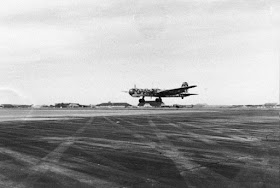
I was half-expecting authors Creek and Smith to rehabilitate the He 177 in their Classic Publications tome devoted to the He 177 - according to the author of the Warpaint monograph the He 177 was 'designed with a touch of genius' and 'ruined' by political interference. Needless to say Smith & Creek have other ideas - the type actually is as bad as the mythology would have us believe. In fact they describe it at one point in their text as "completely useless " - so much for German aeronautical engineering prowess, especially when compared -as the authors do over the first twenty pages of their Classic Publications text - with concurrent heavy bomber developments in the US & UK. The prototype He 177 first flew in late 1939 (three of the first five machines crashing & burning) and the type wasn't cleared for operations until mid-1943. Less than a year later the He 177's operational career was effectively over; from page 39 the book is one long litany of failure. Engine fires, diving & stalling trials, the poorly designed & weak wing, all killed many skilled crews as the Luftwaffe struggled to bring the He 177 into service. Over one thousand were built; less than 200 flew combat sorties. As for political interference... Göring appears to be one of the saner, more rational voices in the whole sorry business, but rather like AH & the Me 262 the scientists and engineers weren't listening to him. The increasing frustration among the higher ranks of the Luftwaffe with the delays and failures soon led him to demand a conventional four-engine type to replace this "ramshackle old tin can". The various plans to replace the coupled engines with four single engines, and/or create a new aircraft based on it such as the He 277 or the high-altitude He 274 are also covered.
The brief late war service of the He 177 is of considerable interest, in particular the reminiscences from a KG 100 missile technician - operations with guided anti-ship weapons such as the Fritz-X and Hs 293 are described in some detail. While Ulf Balke is credited with some photos, some pilot accounts from his KG 100 book would have been useful here - his father flew the He 177 with KG 100. In the west the type flew sorties in the 'mini-Blitz' against London (Steinbock) and attacked shipping off the D-Day beaches, while on the Eastern Front some strategic bombing raids were flown along with suicidal low-level sorties against Soviet tank formations. By now the design had "matured" into the He 177A-5 sub-type, strengthened and re-engined, potentially a capable bomber if well trained crews and (importantly) maintenance support had been available. But they rarely were. The British and Americans each flew a captured He 177 at the end of the war and there is a chapter of pilot impressions (Capt. Eric Brown and Col. Harold E. Watson) - 'a real clunker of an airplane'. There is also a lengthy set of appendices & more importantly for the modellers a nice reproduction of the type handbook with lots of clear images.
To sum up, well produced, copiously illustrated and very readable. Comparisons with the Griehl book published by Airlife are probably inevitable... in some areas Griehl has more detail (French service) but Smith & Creek tell the story of the He 177 in a much clearer & a more 'entertaining' way. Unfortunately many of the photographs are the same in both books but reproduction is better in the Classic volume. The Classic colour artworks are an additional feature of course and are well done, but the book has to be turned up the other way to view them. I'd also liked to have seen more pics from those expensive French archives such as the one below which does not appear in the book - the He 177 saw most of its service in France - but then I guess you can't have everything.
He 177 A-5 probably of KG 100 (via Lorant)

He 177 A-1 VB+UN photographed on the compass swing platform at Rechlin during 1942 from an aircraft taxiing alongside

A selection of Bundesarchiv/Wiki Commons images that are free for re-use on the web































